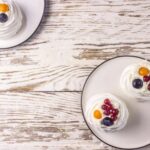Are you looking to add an extra touch of pizzazz to your homemade cakes? Look no further than learning how to decorate cake with dripping icing. The trend of using dripping icing has taken the baking world by storm, and for good reason. It adds a dramatic and delicious element to any cake, instantly elevating it from ordinary to extraordinary.
Whether you’re a beginner or an experienced baker, mastering the art of dripping icing can take your confectionary skills to the next level. In this comprehensive guide, we will explore everything you need to know about creating the perfect drip effect on your cakes. From understanding different types of icing to troubleshooting common mistakes, we’ve got you covered.
Join us as we delve into the basics of cake decoration and provide step-by-step instructions on preparing your cake for dripping icing. We’ll also discuss how to select the right icing for a beautiful drip effect and explore techniques for achieving the perfect drip.
Plus, we’ll share tips on adding extra flair with toppings and decorations, as well as final touches for presentation that will make your cake a showstopper. With our guidance, you’ll be well on your way to becoming a pro at decorating cakes with dripping icing.
The Basics of Cake Decoration
When it comes to decorating a cake with dripping icing, understanding the different types of icing is crucial. The most commonly used icings for this purpose are ganache, royal icing, and buttercream. Ganache is made from chocolate and cream, providing a rich and smooth texture perfect for creating a glossy, decadent drip effect.
Royal icing, on the other hand, is a mixture of confectioners’ sugar and egg whites, which hardens as it dries, allowing for more intricate designs when decorating. Lastly, buttercream is a classic choice known for its creamy consistency and versatility in both taste and design.
Ganache is often the preferred choice for achieving the perfect drip due to its ability to create a smooth finish and hold its shape well. On the other hand, royal icing can be more challenging to work with when creating a drip effect due to its tendency to harden quickly. Buttercream, while delicious and easy to work with in terms of piping and shaping, may require some adjustments in order to achieve the optimal dripping consistency.
Each type of icing has its own unique qualities that can greatly impact the overall look and taste of your cake. By understanding these differences, you will be better equipped to select the right type of icing for your specific design and desired effect.
| Type of Icing | Main Ingredients |
|---|---|
| Ganache | Chocolate and Cream |
| Royal Icing | Confectioners’ Sugar and Egg Whites |
| Buttercream | Butter or Shortening with Confectioners’ Sugar and Flavoring |
Preparing Your Cake for Dripping Icing
Leveling and Crumbing
Before you can start applying dripping icing to your cake, it’s important to ensure that the surface is level and smooth. Leveling the cake layers and applying a crumb coat are essential steps in creating a flawless base for dripping icing.
Use a long serrated knife or cake leveler to even out the tops of each layer, then apply a thin layer of frosting to seal in any crumbs. This will provide a clean canvas for the dripping icing to adhere to.
Chilling the Cake
To further prepare your cake for dripping icing, it’s beneficial to chill it in the refrigerator after applying the crumb coat. Chilling the cake helps the frosting set and creates a firm base for the dripping icing to cling to.
Place the cake in the refrigerator for at least 30 minutes before attempting to apply the dripping icing. Keep in mind that a well-chilled cake will make it easier to achieve precise drips without them running too far down the sides.
Choosing the Right Shape
The shape of your cake can also influence how well the dripping icing will look on the finished product. Cakes with defined edges and straight sides tend to showcase dripping icing beautifully, as it cascades down the sides in an elegant manner.
Consider using taller cake pans with straight edges rather than angled or fluted pans if you want your drips to be more pronounced. Additionally, consider using sturdy fillings and frostings that won’t cause your layers to shift or slide during assembly, which can ultimately affect how well you’re able to create ideal drip patterns on your finished product.
Selecting the Right Icing for a Dripping Effect
When it comes to decorating cakes with dripping icing, selecting the right type of icing is crucial in achieving the perfect drip effect. There are several factors to consider when choosing the type of icing for your cake decoration project. Here are some factors to keep in mind:
- Consistency: The consistency of the icing plays a significant role in achieving a smooth, even drip. Thicker icings tend to create a more pronounced drip, while thinner icings may result in a more subtle effect.
- Temperature: The temperature of the icing is also important. Icing that is too runny or too stiff can make it challenging to achieve the desired drip effect. It’s essential to find the right balance, and this often requires some trial and error.
- Color and flavor: The color and flavor of the icing should complement the overall design and taste of the cake. Consider using colored or flavored icing for a unique and eye-catching drip effect.
Taking these factors into consideration will help you select the perfect icing for achieving a beautiful drip effect on your cake. Experimenting with different types of icing and adjusting their consistency and temperature will allow you to find the ideal combination for your specific cake decoration project.
Remember that practice makes perfect, so don’t be discouraged if you don’t get it right on your first attempt. With patience and experimentation, you’ll be able to master the art of selecting the right icing for creating stunning drip effects on your cakes.
Techniques for Achieving the Perfect Drip
When it comes to achieving the perfect drip on your cake, there are several techniques that can help you achieve this stunning look. Whether you prefer a subtle drip or a bold and dramatic one, mastering the art of dripping icing can elevate your cake decorating skills to new heights.
1. Consistency Is Key
The first step in achieving the perfect drip is to ensure that your icing or ganache is the right consistency. The ideal texture for dripping icing is slightly thick but still pourable.
If the icing is too runny, it will slide right off the sides of the cake, while if it’s too thick, it won’t create that elegant dripping effect. To achieve the perfect consistency, you may need to adjust the ratio of liquid to sugar in your icing recipe.
2. Drip Placement
Next, consider where you want the drips to fall on your cake. Typically, drips are added around the edges of the cake, allowing them to cascade down the sides. To achieve a more controlled drip pattern, you can strategically place spoonfuls of icing at specific points around the top edge of the cake and let gravity do its work.
3. Patience and Precision
Achieving an even and consistent drip requires patience and precision. Slowly pour a small amount of icing onto the edge of the cake and use an offset spatula to carefully nudge it towards the edge, allowing it to naturally flow down. Take your time with each drip, ensuring that they are evenly spaced and vary in length for a visually appealing effect.
By following these step-by-step techniques for achieving the perfect drip on your cake, you can create a visually stunning dessert that will impress any audience. Remember to practice and experiment with different consistencies and pouring techniques until you find what works best for your desired aesthetic.
Adding Extra Flair
Once you have achieved the perfect drip on your cake, it’s time to add some extra flair with toppings and decorations. Whether you want to keep it simple or go all out, there are endless possibilities for enhancing the visual appeal of your cake.
Here are some ideas for incorporating toppings and decorations with the dripping icing:
- Fresh fruits: Adding fresh fruits like berries, sliced mangoes, or kiwi can add a burst of color and freshness to your cake. Place them strategically along the drips or on top of the cake for a beautiful presentation.
- Edible flowers: Edible flowers are a great way to elevate the look of your cake. Choose flowers that are pesticide-free and safe for consumption, such as roses, pansies, or violets. Gently place them on the drips or arrange them in clusters for an elegant touch.
- Chocolate drizzle: If you’re using a white or colored icing for the drip, consider adding a contrasting chocolate drizzle on top. Use a piping bag or spoon to create thin lines of chocolate over the icing drips for a stunning effect.
Incorporating toppings and decorations with dripping icing allows you to get creative and customize your cake according to different themes, occasions, or personal preferences. Experiment with various combinations until you achieve a look that is both visually appealing and delicious.
Common Mistakes to Avoid When Decorating With Dripping Icing
Decorating a cake with dripping icing can be a fun and visually stunning way to add flair to your confection. However, there are common mistakes that can occur when attempting this decorative technique.
One of the most common mistakes is using icing that is too thin or too thick, resulting in drips that are uneven or don’t hold their shape. To avoid this, it’s important to find the right consistency for your icing by adjusting the amount of liquid used in your recipe.
Another mistake to watch out for is applying the dripping icing on a cake that is not properly chilled. If the cake is too warm, the icing will slide down too quickly and may create a messy appearance. It’s crucial to chill your cake in the refrigerator for at least 30 minutes before adding the dripping icing. This will help slow down the dripping process and ensure a more controlled and aesthetically pleasing result.
Additionally, one common mistake that novice bakers often make when decorating with dripping icing is overloading the cake with too much icing. This can lead to an overwhelming and unbalanced look, as well as causing an excessive mess on the serving platter or table. To avoid this, carefully control the amount of icing you use and start with small drips, gradually adding more as needed to achieve your desired effect.
| Common Mistakes | Troubleshooting Tips |
|---|---|
| Using icing that is too thin or too thick | Adjust the amount of liquid in your recipe to achieve the right consistency |
| Applying icing on a warm cake | Chill the cake for at least 30 minutes before adding dripping icing for better control |
| Overloading the cake with too much icing | Carefully control the amount of icing used, starting with small drips and adding more as needed |
Final Touches and Presentation
After perfecting the technique of creating a beautiful dripping icing effect on your cake, it’s time to add the final touches and present your creation as a showstopper. These last steps are crucial in elevating the overall look of your cake and making it irresistible to anyone who lays eyes on it.
One way to make your cake stand out is by carefully selecting and arranging toppings and decorations that complement the dripping icing. Fresh fruits like berries, sliced kiwi, or tropical fruits can add a vibrant pop of color and freshness to your cake.
You can also consider using edible flowers, chocolate shavings, or even small candies for a fun and playful touch. The key is to strike a balance between the toppings and the dripping icing, ensuring that they enhance each other rather than compete for attention.
In addition to the toppings, the presentation of your cake plays a significant role in making it visually appealing. Consider using a cake stand or platter that enhances the overall aesthetic of the cake. Pay attention to details like adding a dusting of powdered sugar, cocoa powder, or edible glitter for an extra touch of elegance. The way you display and showcase your cake can make all the difference in making it truly stand out as a work of art.
Remember, while it’s important to focus on aesthetics, the flavor and taste of your cake should not be overshadowed by its appearance. Make sure that the flavors of your cake layers, fillings, and icing complement each other harmoniously for an unforgettable sensory experience. With these final touches and presentation considerations, you’ll be sure to create a showstopping masterpiece that will impress any crowd.
Conclusion
In conclusion, mastering the art of decorating cakes with dripping icing can truly elevate your baking skills and impress anyone who lays their eyes on your creations. Understanding the basics of cake decoration and selecting the right icing are crucial first steps in this process. By following the techniques outlined in this article, you can achieve the perfect drip every time, adding that extra flair to your cake with toppings and decorations for a showstopping presentation.
It’s important to remember that practice makes perfect, and even if you encounter some common mistakes along the way, there are always troubleshooting tips to help you correct them. With patience and persistence, you can overcome any obstacles and continue to improve your skills in cake decoration with dripping icing.
Ultimately, a beautifully decorated cake with dripping icing is not just a treat for the taste buds but also a feast for the eyes. Whether it’s for a special occasion or simply as a creative outlet, this art form allows you to showcase your personality and creativity through delectable desserts. So go ahead and experiment with different flavors, colors, and designs to create stunning cakes that will leave a lasting impression on all who indulge in them.
Frequently Asked Questions
How Do You Do Drip Icing on a Cake?
Drip icing on a cake is created by making a slightly runny icing or ganache, which is then drizzled over the edges of the cake. The key is to achieve the right consistency of the icing or ganache so that it drips down the sides of the cake in a smooth and controlled manner.
This can be achieved through practice and adjusting the thickness of the icing.
How Do You Make Drip Marks on a Cake?
Drip marks on a cake are typically made by allowing thinned out icing or ganache to flow over the edges of the cake, creating a dripping effect as it runs down the sides.
It’s important to have good control over how much drips down and where they fall, as this can greatly affect the overall appearance of the finished cake.
Can You Use a Piping Bag for a Drip Cake?
Yes, a piping bag can be used for creating a drip effect on a cake. The thinned out icing or ganache can be carefully piped around the edge of the cake, allowing it to drip down naturally.
This method requires some precision and control to achieve even drips around the entire perimeter of the cake. Using a piping bag can help create a more uniform and controlled drip pattern on the cake’s surface.

Welcome to my blog about home and family. This blog is a place where I will share my thoughts, ideas, and experiences related to these important topics. I am a stay-at-home mom with two young children. I hope you enjoy reading it! and may find some helpful tips and ideas that will make your home and family life even better!





